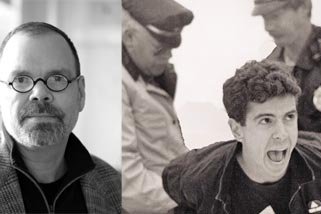Chronicling the empowerment of the gay community and its supporters as they came together to fight for rights for people with AIDS, “How to Survive a Plague” is a truly exceptional documentary. It opens at Ritz Theatres Oct. 12.
The film’s pre-credit sequences, which depict protestors being dragged away, are powerful and often tearjerking. How can anyone do nothing — or worse, condemn those who are suffering — in an epidemic where millions of people are dying from neglect?
Filmmaker David France effectively captures the activism — from kiss-ins to the wrapping of Sen. Jesse Helms’ house in a condom — that was meant to provoke a response from President George H.W. Bush, New York Archbishop John Cardinal O’Connor and big pharma, among others. It is impossible not to be moved by images of survivors of AIDS victims showering the White House lawn with the ashes of their loved ones.
“How to Survive a Plague” showcases the efforts of unlikely activists, like once-closeted bond trader Peter Staley and former senior public-relations executive Bob Rafsky, to mobilize and inspire a community — be it at a conference where support is being demanded or at a funeral for an AIDS victim. The testimony of these self-educated members is articulate, heartfelt and incredibly rousing.
France also clearly unpacks the medical challenges that surrounded AIDS treatment in its early years, as well as how the gay community educated itself to work with scientists and the splintering of ACT UP. This film documents life during wartime, and watching the battles won and lost is truly heartening.
In a recent phone interview, France spoke to PGN about his phenomenal film. PGN: What was your experience during the heyday of ACT UP? DF: I was a journalist on the ground. I had been covering the epidemic for a number of years by the time ACT UP came along. I attended the meetings. It was the town square, where all info was exchanged. I was covering what they were doing, and I followed up on their discoveries.
PGN: What made you want to tell this story of ACT UP now? DF: I wanted to enrich the record of those years because we have memorialized the plague years through plays, films and books produced in the middle of those years. They chronicled frankness when this mysterious killer invaded the community — not how HIV devastated us, but how we devastated HIV. In 1996 to 1997, the change in America — how drugs are tested, regulated and marketed — was created by AIDS activism. Ultimately, the virus was brought to its knees by the interactions and collaboration of activists, people with HIV and their advocates who fought to save their lives and interact with the scientists doing the work. It’s a great American story of triumph. It’s a story that has not been told before. PGN: What can you say about the interviews you did? They were quite impassioned. Were people generally interested in talking about their participation? It seems some folks experienced survivor’s guilt. And you must have been dredging up old, painful memories. DF: I should say there was not a great eagerness to talk to me about those years. People who lived through them have chosen — in the sense of the soundness of mind — to put those ugly memories behind them. It was a challenge for me to get them to come, and a challenge to them to rewind their lives to 1987 and tell me what they saw. I was astonished by my own emotional collapse in the middle of the film. I cried in every interview, and it was sometimes impossible for me to ask the next question. It made me realize how profound the scars are for them, how much was invested in this tiny story in the middle of this epidemic. For me, it was a catharsis.
PGN: You deliberately, and effectively, keep the identity of those who survived a mystery until the end. What was your decision for this approach? It is very dramatic and very rewarding. DF: Here’s the decision I made, and held to tenaciously: I wanted the viewer to have the same experience that we who survived that experience had and witnessed. You didn’t know who would live or die from minute to minute. There was absolute uncertainty. The goal and opportunity was that you could experience these events in real time through the archive footage.
PGN: What, for you, was the most important or powerful moment — the “get,” as I call it? DF: I was stunned to see the tape of Larry Kramer in the middle of this divisive, cancerous moment where the activists turn on each other [at a meeting]. It was a piece of footage from that time that captured both the anxiety and dread among the combatants, and the camera held on Kramer’s face when he explodes into this speech trying to bring everyone back into the boat to keep this campaign going. It captures so brilliantly what Kramer’s power has been — to use a few words to grab the community by the collar and shake them up and remind them what the stakes are and what we’re after. The night we were sitting in the cutting room running the tape , it blew me away.
Mazzoni Center will present a free screening of “How to Survive a Plaque” at 7:30 p.m. Oct. 10 at Ritz Five, 220 Walnut St. Seating is limited. RSVP to [email protected].
